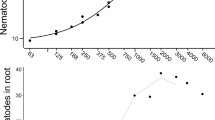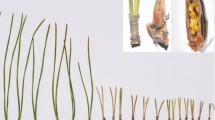Abstract
DURING the examination of a Hippeastrum plant the roots of which were badly attacked by a new species of the nematode genus, Rotylenchus, to be described elsewhere, it was noticed that some of the undamaged parts of the roots were covered with root hairs right up to the base of the bulb. Closer examination showed that the root hairs were of secondary origin, for in some cases the root was still surrounded by the original hypodermis, which was partially sloughed, and the new root hairs were growing beneath it.
This is a preview of subscription content, access via your institution
Access options
Subscribe to this journal
Receive 51 print issues and online access
$199.00 per year
only $3.90 per issue
Buy this article
- Purchase on Springer Link
- Instant access to full article PDF
Prices may be subject to local taxes which are calculated during checkout
Similar content being viewed by others
References
Pinkerton, M. E., Bot. Gaz., 98, 147 (1936).
Cormack, R. G. H., Bot. Rev., 15, 583 (1949).
Quanjer, H. M., Tijschr. PIZiekt., 33, 137 (1927).
Author information
Authors and Affiliations
Rights and permissions
About this article
Cite this article
GOODEY, J. A Secondary Piliferous Layer on the Roots of Hippeastrum. Nature 167, 822–823 (1951). https://doi.org/10.1038/167822a0
Issue Date:
DOI: https://doi.org/10.1038/167822a0
Comments
By submitting a comment you agree to abide by our Terms and Community Guidelines. If you find something abusive or that does not comply with our terms or guidelines please flag it as inappropriate.



